CFD Analysis of Smoke Management in Multi-Storey Buildings: A Project
VerifiedAdded on 2022/10/04
|60
|12073
|64
Project
AI Summary
This project presents a Computational Fluid Dynamics (CFD) analysis of smoke management system strategies in multi-storey structures, focusing on the role of HVAC operations in controlling smoke propagation during fires. The study employs Ansys workbench to model smoke behavior based on varying air supply quantities and temperature changes. The introduction emphasizes the importance of fire safety in high-rise buildings, the challenges of evacuation, and the need for strategies to control smoke and toxic fumes. The literature review covers multi-storey structures, their fire resistance, and the significance of well-defined control measures. The methodology section details the CFD simulation setup, numerical model, boundary conditions, and design of smoke management systems. Results and discussions are presented, followed by conclusions and suggestions for future work. The project aims to assess smoke propagation, develop predictive models, and evaluate the effects of complex geometries on smoke movement, ultimately contributing to improved fire safety in urban environments. The research also investigates the effects of HVAC and supply air for smoke management in multi-level buildings.
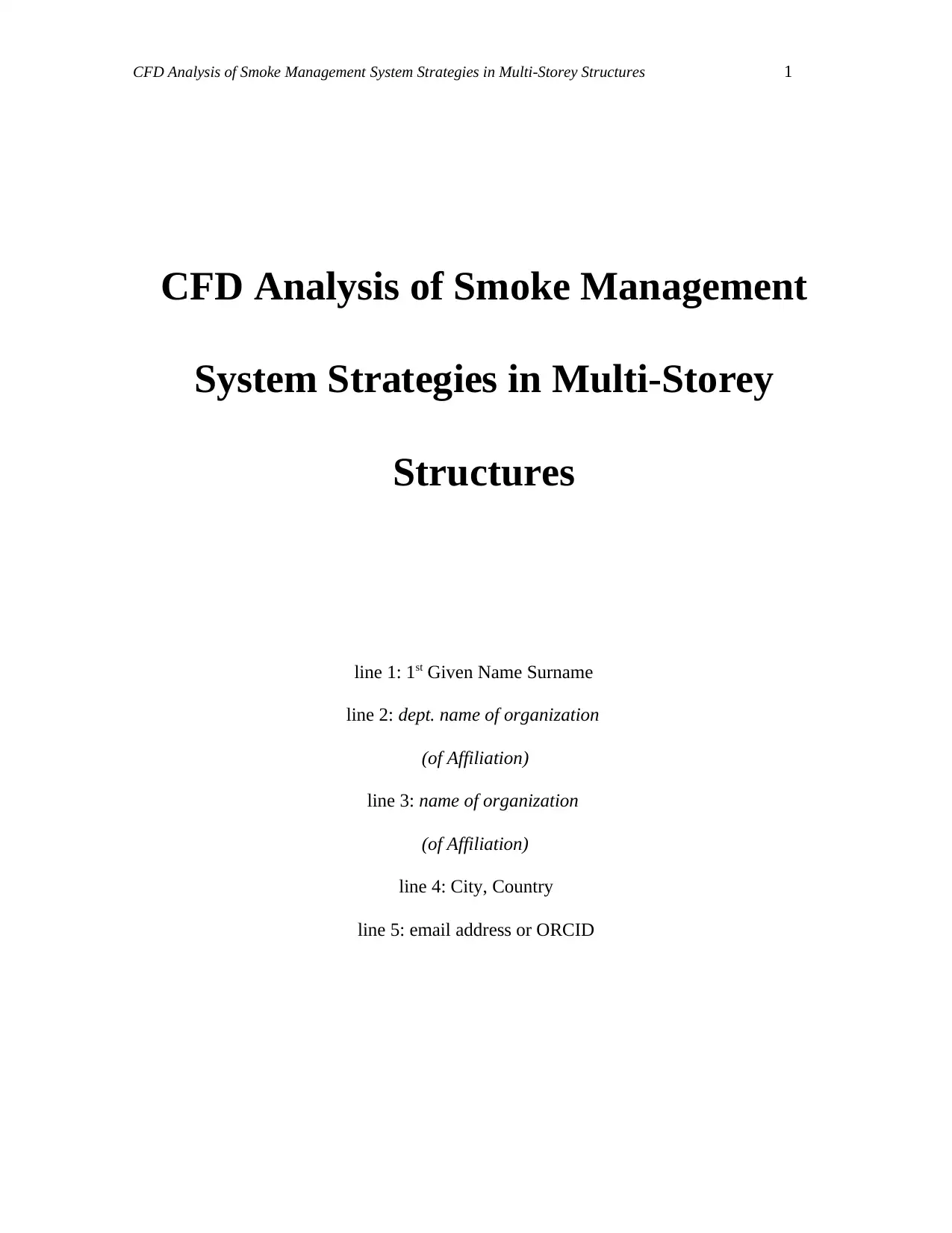
CFD Analysis of Smoke Management System Strategies in Multi-Storey Structures 1
CFD Analysis of Smoke Management
System Strategies in Multi-Storey
Structures
line 1: 1st Given Name Surname
line 2: dept. name of organization
(of Affiliation)
line 3: name of organization
(of Affiliation)
line 4: City, Country
line 5: email address or ORCID
CFD Analysis of Smoke Management
System Strategies in Multi-Storey
Structures
line 1: 1st Given Name Surname
line 2: dept. name of organization
(of Affiliation)
line 3: name of organization
(of Affiliation)
line 4: City, Country
line 5: email address or ORCID
Paraphrase This Document
Need a fresh take? Get an instant paraphrase of this document with our AI Paraphraser
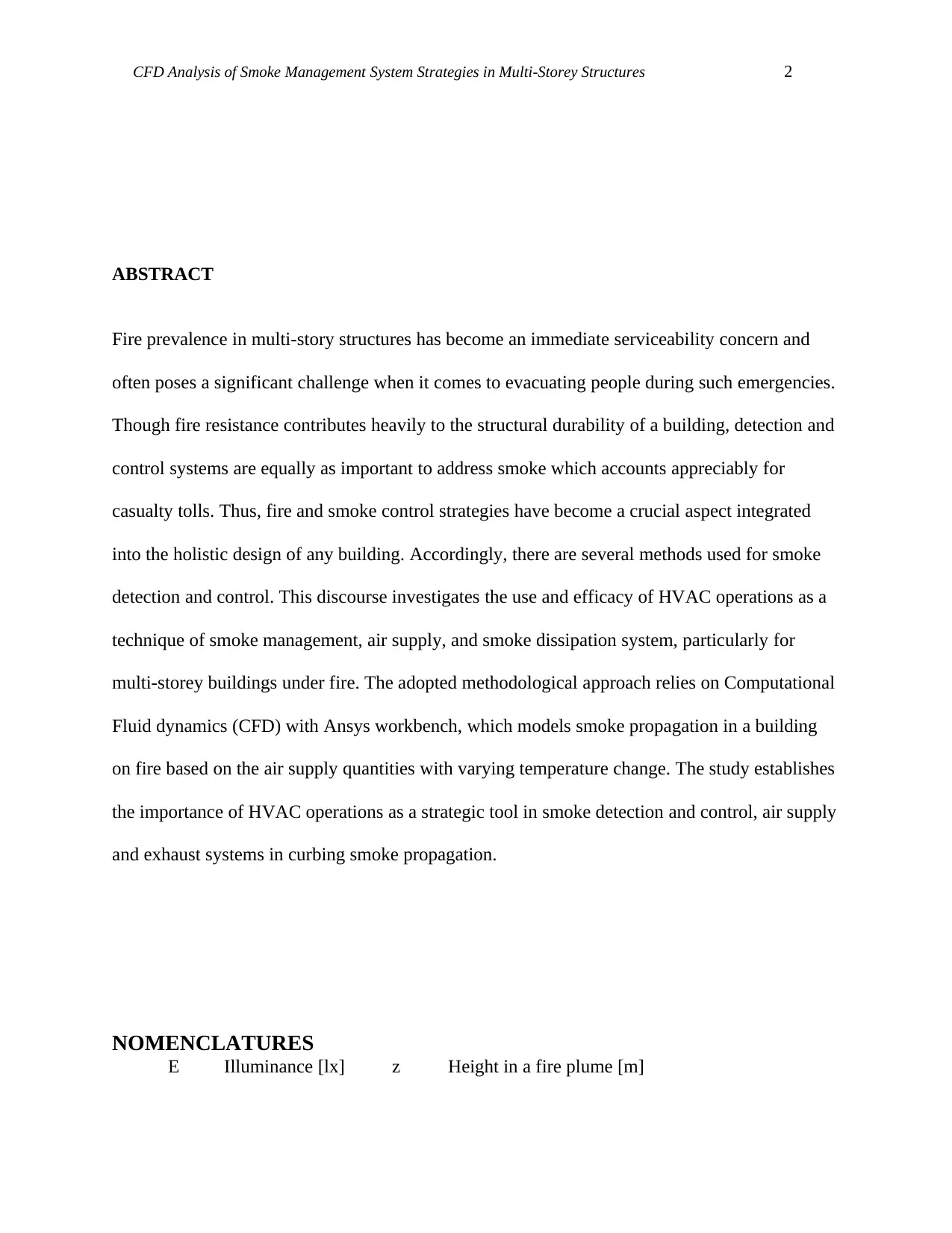
CFD Analysis of Smoke Management System Strategies in Multi-Storey Structures 2
ABSTRACT
Fire prevalence in multi-story structures has become an immediate serviceability concern and
often poses a significant challenge when it comes to evacuating people during such emergencies.
Though fire resistance contributes heavily to the structural durability of a building, detection and
control systems are equally as important to address smoke which accounts appreciably for
casualty tolls. Thus, fire and smoke control strategies have become a crucial aspect integrated
into the holistic design of any building. Accordingly, there are several methods used for smoke
detection and control. This discourse investigates the use and efficacy of HVAC operations as a
technique of smoke management, air supply, and smoke dissipation system, particularly for
multi-storey buildings under fire. The adopted methodological approach relies on Computational
Fluid dynamics (CFD) with Ansys workbench, which models smoke propagation in a building
on fire based on the air supply quantities with varying temperature change. The study establishes
the importance of HVAC operations as a strategic tool in smoke detection and control, air supply
and exhaust systems in curbing smoke propagation.
NOMENCLATURES
E Illuminance [lx] z Height in a fire plume [m]
ABSTRACT
Fire prevalence in multi-story structures has become an immediate serviceability concern and
often poses a significant challenge when it comes to evacuating people during such emergencies.
Though fire resistance contributes heavily to the structural durability of a building, detection and
control systems are equally as important to address smoke which accounts appreciably for
casualty tolls. Thus, fire and smoke control strategies have become a crucial aspect integrated
into the holistic design of any building. Accordingly, there are several methods used for smoke
detection and control. This discourse investigates the use and efficacy of HVAC operations as a
technique of smoke management, air supply, and smoke dissipation system, particularly for
multi-storey buildings under fire. The adopted methodological approach relies on Computational
Fluid dynamics (CFD) with Ansys workbench, which models smoke propagation in a building
on fire based on the air supply quantities with varying temperature change. The study establishes
the importance of HVAC operations as a strategic tool in smoke detection and control, air supply
and exhaust systems in curbing smoke propagation.
NOMENCLATURES
E Illuminance [lx] z Height in a fire plume [m]
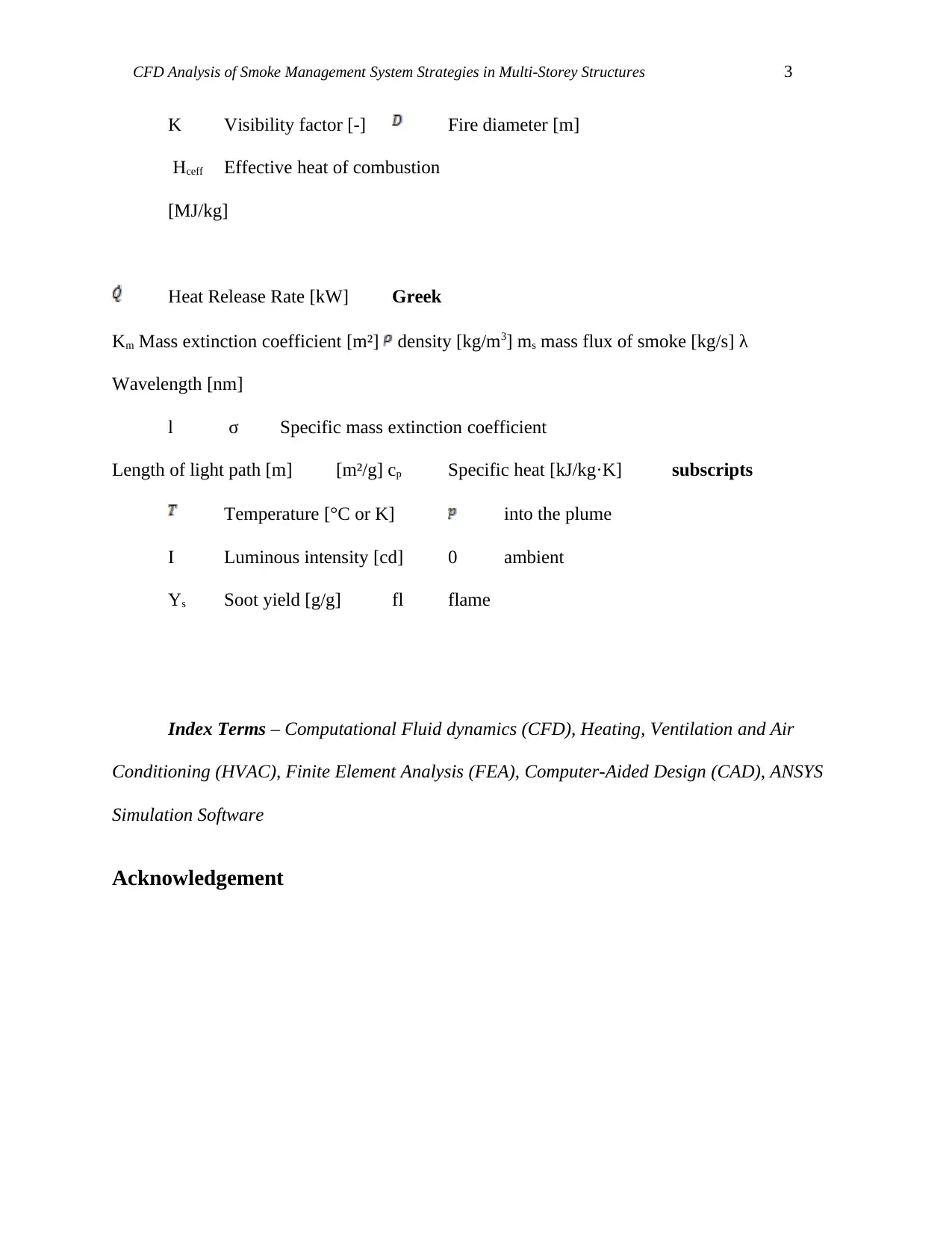
CFD Analysis of Smoke Management System Strategies in Multi-Storey Structures 3
K Visibility factor [-] Fire diameter [m]
Hceff Effective heat of combustion
[MJ/kg]
Heat Release Rate [kW] Greek
Km Mass extinction coefficient [m²] density [kg/m3] ms mass flux of smoke [kg/s] λ
Wavelength [nm]
l σ Specific mass extinction coefficient
Length of light path [m] [m²/g] cp Specific heat [kJ/kg·K] subscripts
Temperature [°C or K] into the plume
I Luminous intensity [cd] 0 ambient
Ys Soot yield [g/g] fl flame
Index Terms – Computational Fluid dynamics (CFD), Heating, Ventilation and Air
Conditioning (HVAC), Finite Element Analysis (FEA), Computer-Aided Design (CAD), ANSYS
Simulation Software
Acknowledgement
K Visibility factor [-] Fire diameter [m]
Hceff Effective heat of combustion
[MJ/kg]
Heat Release Rate [kW] Greek
Km Mass extinction coefficient [m²] density [kg/m3] ms mass flux of smoke [kg/s] λ
Wavelength [nm]
l σ Specific mass extinction coefficient
Length of light path [m] [m²/g] cp Specific heat [kJ/kg·K] subscripts
Temperature [°C or K] into the plume
I Luminous intensity [cd] 0 ambient
Ys Soot yield [g/g] fl flame
Index Terms – Computational Fluid dynamics (CFD), Heating, Ventilation and Air
Conditioning (HVAC), Finite Element Analysis (FEA), Computer-Aided Design (CAD), ANSYS
Simulation Software
Acknowledgement
⊘ This is a preview!⊘
Do you want full access?
Subscribe today to unlock all pages.

Trusted by 1+ million students worldwide
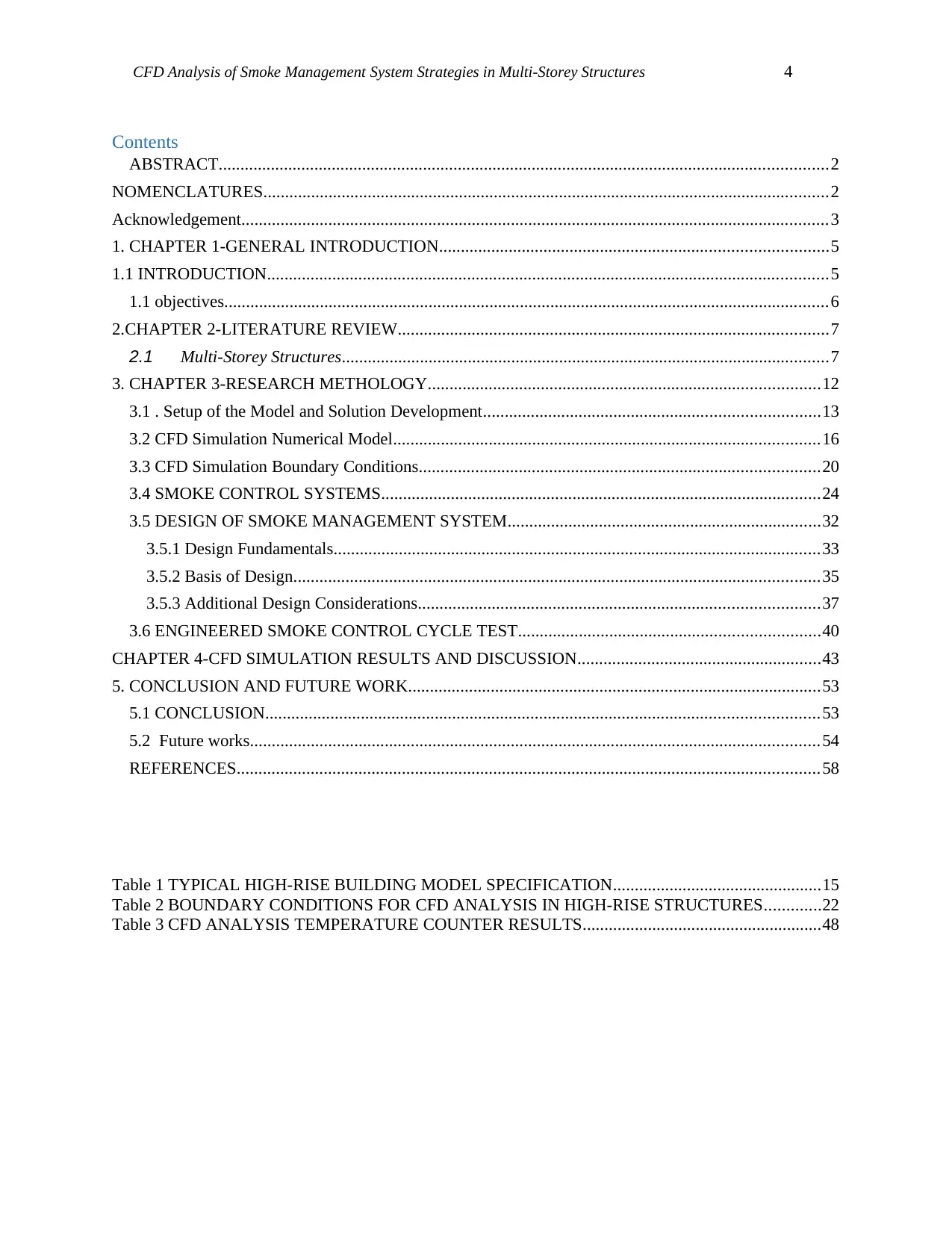
CFD Analysis of Smoke Management System Strategies in Multi-Storey Structures 4
Contents
ABSTRACT............................................................................................................................................2
NOMENCLATURES..................................................................................................................................2
Acknowledgement.......................................................................................................................................3
1. CHAPTER 1-GENERAL INTRODUCTION.........................................................................................5
1.1 INTRODUCTION.................................................................................................................................5
1.1 objectives...........................................................................................................................................6
2.CHAPTER 2-LITERATURE REVIEW...................................................................................................7
2.1 Multi-Storey Structures................................................................................................................7
3. CHAPTER 3-RESEARCH METHOLOGY..........................................................................................12
3.1 . Setup of the Model and Solution Development.............................................................................13
3.2 CFD Simulation Numerical Model..................................................................................................16
3.3 CFD Simulation Boundary Conditions............................................................................................20
3.4 SMOKE CONTROL SYSTEMS.....................................................................................................24
3.5 DESIGN OF SMOKE MANAGEMENT SYSTEM........................................................................32
3.5.1 Design Fundamentals................................................................................................................33
3.5.2 Basis of Design.........................................................................................................................35
3.5.3 Additional Design Considerations............................................................................................37
3.6 ENGINEERED SMOKE CONTROL CYCLE TEST.....................................................................40
CHAPTER 4-CFD SIMULATION RESULTS AND DISCUSSION........................................................43
5. CONCLUSION AND FUTURE WORK...............................................................................................53
5.1 CONCLUSION...............................................................................................................................53
5.2 Future works...................................................................................................................................54
REFERENCES......................................................................................................................................58
Table 1 TYPICAL HIGH-RISE BUILDING MODEL SPECIFICATION................................................15
Table 2 BOUNDARY CONDITIONS FOR CFD ANALYSIS IN HIGH-RISE STRUCTURES.............22
Table 3 CFD ANALYSIS TEMPERATURE COUNTER RESULTS.......................................................48
Contents
ABSTRACT............................................................................................................................................2
NOMENCLATURES..................................................................................................................................2
Acknowledgement.......................................................................................................................................3
1. CHAPTER 1-GENERAL INTRODUCTION.........................................................................................5
1.1 INTRODUCTION.................................................................................................................................5
1.1 objectives...........................................................................................................................................6
2.CHAPTER 2-LITERATURE REVIEW...................................................................................................7
2.1 Multi-Storey Structures................................................................................................................7
3. CHAPTER 3-RESEARCH METHOLOGY..........................................................................................12
3.1 . Setup of the Model and Solution Development.............................................................................13
3.2 CFD Simulation Numerical Model..................................................................................................16
3.3 CFD Simulation Boundary Conditions............................................................................................20
3.4 SMOKE CONTROL SYSTEMS.....................................................................................................24
3.5 DESIGN OF SMOKE MANAGEMENT SYSTEM........................................................................32
3.5.1 Design Fundamentals................................................................................................................33
3.5.2 Basis of Design.........................................................................................................................35
3.5.3 Additional Design Considerations............................................................................................37
3.6 ENGINEERED SMOKE CONTROL CYCLE TEST.....................................................................40
CHAPTER 4-CFD SIMULATION RESULTS AND DISCUSSION........................................................43
5. CONCLUSION AND FUTURE WORK...............................................................................................53
5.1 CONCLUSION...............................................................................................................................53
5.2 Future works...................................................................................................................................54
REFERENCES......................................................................................................................................58
Table 1 TYPICAL HIGH-RISE BUILDING MODEL SPECIFICATION................................................15
Table 2 BOUNDARY CONDITIONS FOR CFD ANALYSIS IN HIGH-RISE STRUCTURES.............22
Table 3 CFD ANALYSIS TEMPERATURE COUNTER RESULTS.......................................................48
Paraphrase This Document
Need a fresh take? Get an instant paraphrase of this document with our AI Paraphraser
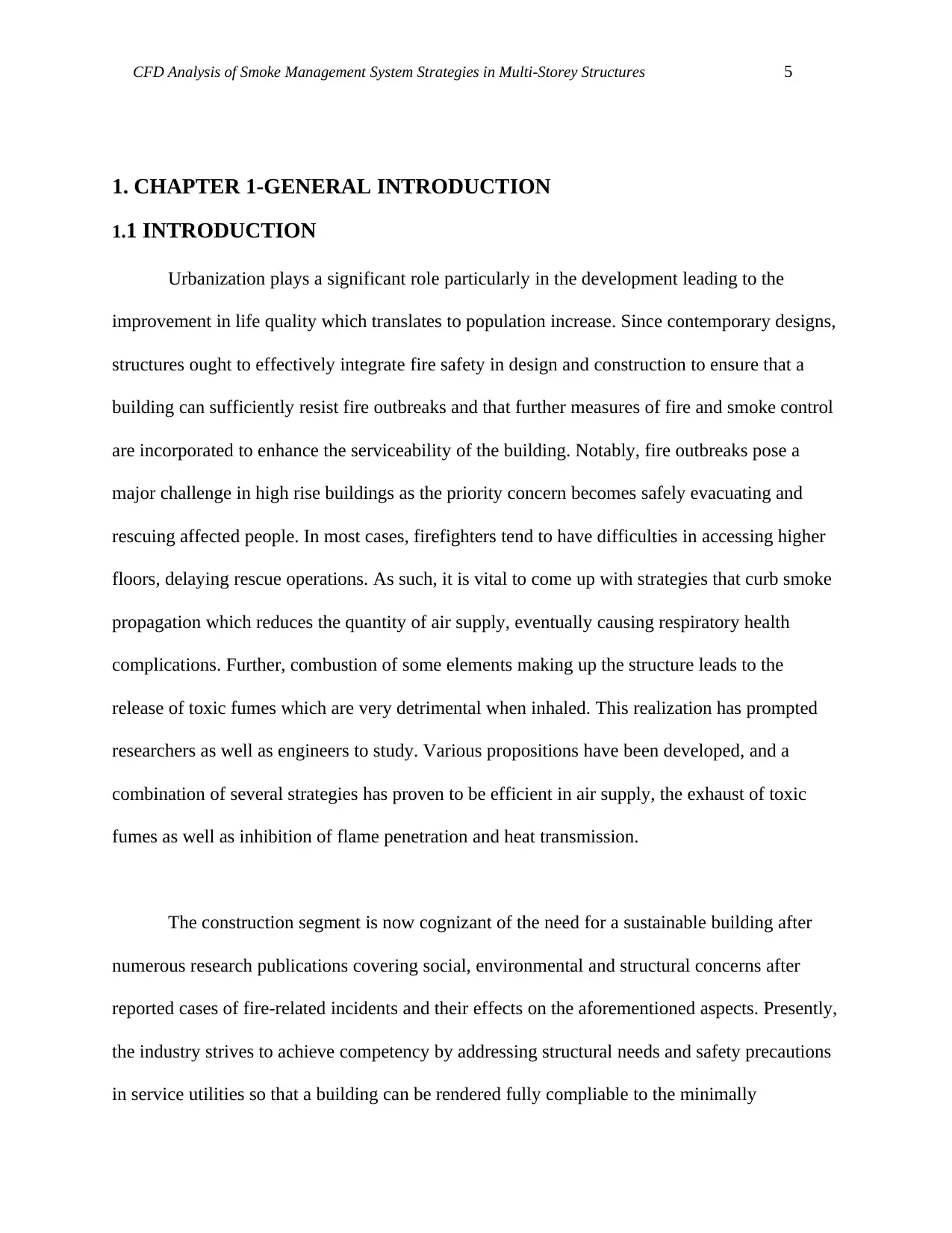
CFD Analysis of Smoke Management System Strategies in Multi-Storey Structures 5
1. CHAPTER 1-GENERAL INTRODUCTION
1.1 INTRODUCTION
Urbanization plays a significant role particularly in the development leading to the
improvement in life quality which translates to population increase. Since contemporary designs,
structures ought to effectively integrate fire safety in design and construction to ensure that a
building can sufficiently resist fire outbreaks and that further measures of fire and smoke control
are incorporated to enhance the serviceability of the building. Notably, fire outbreaks pose a
major challenge in high rise buildings as the priority concern becomes safely evacuating and
rescuing affected people. In most cases, firefighters tend to have difficulties in accessing higher
floors, delaying rescue operations. As such, it is vital to come up with strategies that curb smoke
propagation which reduces the quantity of air supply, eventually causing respiratory health
complications. Further, combustion of some elements making up the structure leads to the
release of toxic fumes which are very detrimental when inhaled. This realization has prompted
researchers as well as engineers to study. Various propositions have been developed, and a
combination of several strategies has proven to be efficient in air supply, the exhaust of toxic
fumes as well as inhibition of flame penetration and heat transmission.
The construction segment is now cognizant of the need for a sustainable building after
numerous research publications covering social, environmental and structural concerns after
reported cases of fire-related incidents and their effects on the aforementioned aspects. Presently,
the industry strives to achieve competency by addressing structural needs and safety precautions
in service utilities so that a building can be rendered fully compliable to the minimally
1. CHAPTER 1-GENERAL INTRODUCTION
1.1 INTRODUCTION
Urbanization plays a significant role particularly in the development leading to the
improvement in life quality which translates to population increase. Since contemporary designs,
structures ought to effectively integrate fire safety in design and construction to ensure that a
building can sufficiently resist fire outbreaks and that further measures of fire and smoke control
are incorporated to enhance the serviceability of the building. Notably, fire outbreaks pose a
major challenge in high rise buildings as the priority concern becomes safely evacuating and
rescuing affected people. In most cases, firefighters tend to have difficulties in accessing higher
floors, delaying rescue operations. As such, it is vital to come up with strategies that curb smoke
propagation which reduces the quantity of air supply, eventually causing respiratory health
complications. Further, combustion of some elements making up the structure leads to the
release of toxic fumes which are very detrimental when inhaled. This realization has prompted
researchers as well as engineers to study. Various propositions have been developed, and a
combination of several strategies has proven to be efficient in air supply, the exhaust of toxic
fumes as well as inhibition of flame penetration and heat transmission.
The construction segment is now cognizant of the need for a sustainable building after
numerous research publications covering social, environmental and structural concerns after
reported cases of fire-related incidents and their effects on the aforementioned aspects. Presently,
the industry strives to achieve competency by addressing structural needs and safety precautions
in service utilities so that a building can be rendered fully compliable to the minimally
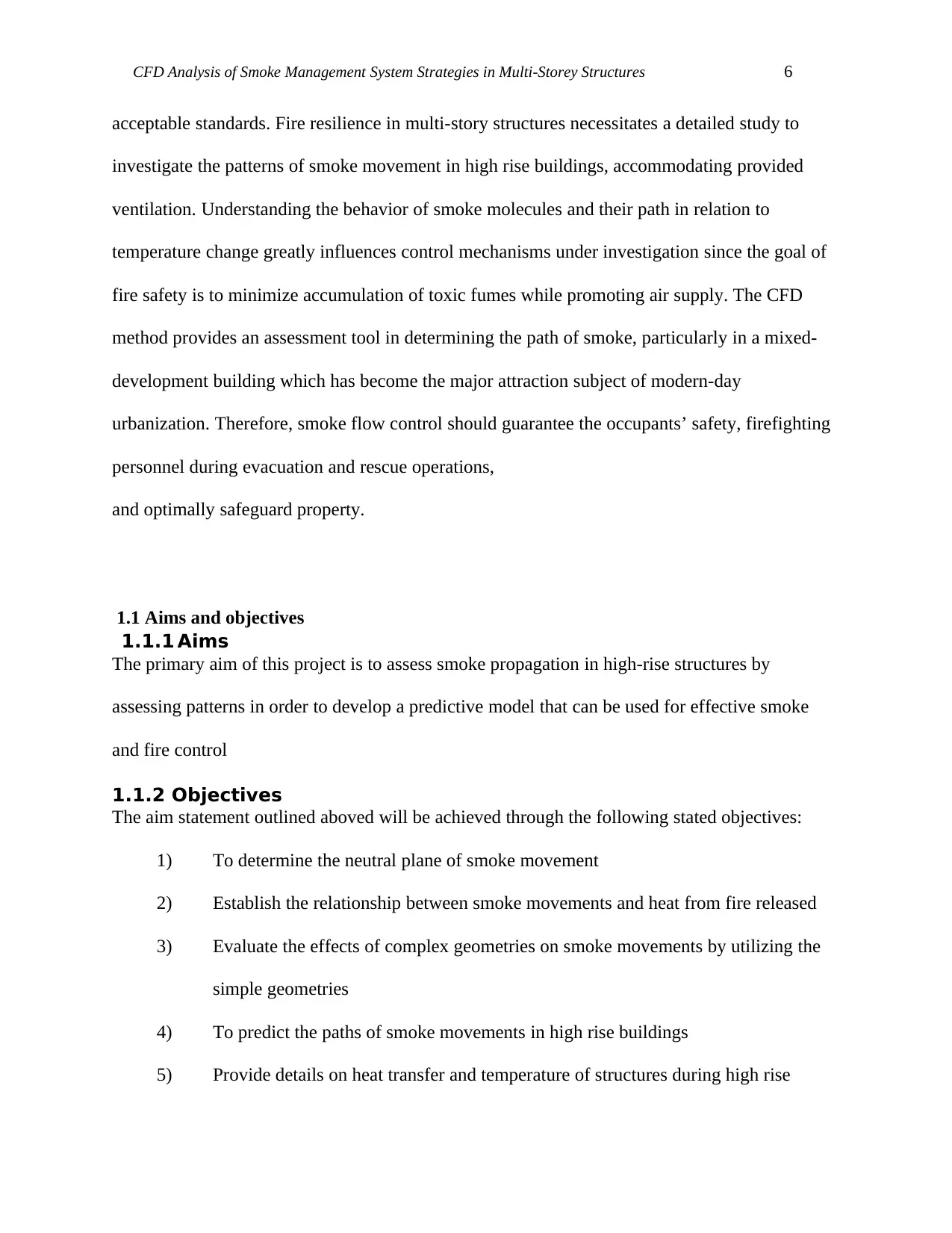
CFD Analysis of Smoke Management System Strategies in Multi-Storey Structures 6
acceptable standards. Fire resilience in multi-story structures necessitates a detailed study to
investigate the patterns of smoke movement in high rise buildings, accommodating provided
ventilation. Understanding the behavior of smoke molecules and their path in relation to
temperature change greatly influences control mechanisms under investigation since the goal of
fire safety is to minimize accumulation of toxic fumes while promoting air supply. The CFD
method provides an assessment tool in determining the path of smoke, particularly in a mixed-
development building which has become the major attraction subject of modern-day
urbanization. Therefore, smoke flow control should guarantee the occupants’ safety, firefighting
personnel during evacuation and rescue operations,
and optimally safeguard property.
1.1 Aims and objectives
1.1.1 Aims
The primary aim of this project is to assess smoke propagation in high-rise structures by
assessing patterns in order to develop a predictive model that can be used for effective smoke
and fire control
1.1.2 Objectives
The aim statement outlined aboved will be achieved through the following stated objectives:
1) To determine the neutral plane of smoke movement
2) Establish the relationship between smoke movements and heat from fire released
3) Evaluate the effects of complex geometries on smoke movements by utilizing the
simple geometries
4) To predict the paths of smoke movements in high rise buildings
5) Provide details on heat transfer and temperature of structures during high rise
acceptable standards. Fire resilience in multi-story structures necessitates a detailed study to
investigate the patterns of smoke movement in high rise buildings, accommodating provided
ventilation. Understanding the behavior of smoke molecules and their path in relation to
temperature change greatly influences control mechanisms under investigation since the goal of
fire safety is to minimize accumulation of toxic fumes while promoting air supply. The CFD
method provides an assessment tool in determining the path of smoke, particularly in a mixed-
development building which has become the major attraction subject of modern-day
urbanization. Therefore, smoke flow control should guarantee the occupants’ safety, firefighting
personnel during evacuation and rescue operations,
and optimally safeguard property.
1.1 Aims and objectives
1.1.1 Aims
The primary aim of this project is to assess smoke propagation in high-rise structures by
assessing patterns in order to develop a predictive model that can be used for effective smoke
and fire control
1.1.2 Objectives
The aim statement outlined aboved will be achieved through the following stated objectives:
1) To determine the neutral plane of smoke movement
2) Establish the relationship between smoke movements and heat from fire released
3) Evaluate the effects of complex geometries on smoke movements by utilizing the
simple geometries
4) To predict the paths of smoke movements in high rise buildings
5) Provide details on heat transfer and temperature of structures during high rise
⊘ This is a preview!⊘
Do you want full access?
Subscribe today to unlock all pages.

Trusted by 1+ million students worldwide
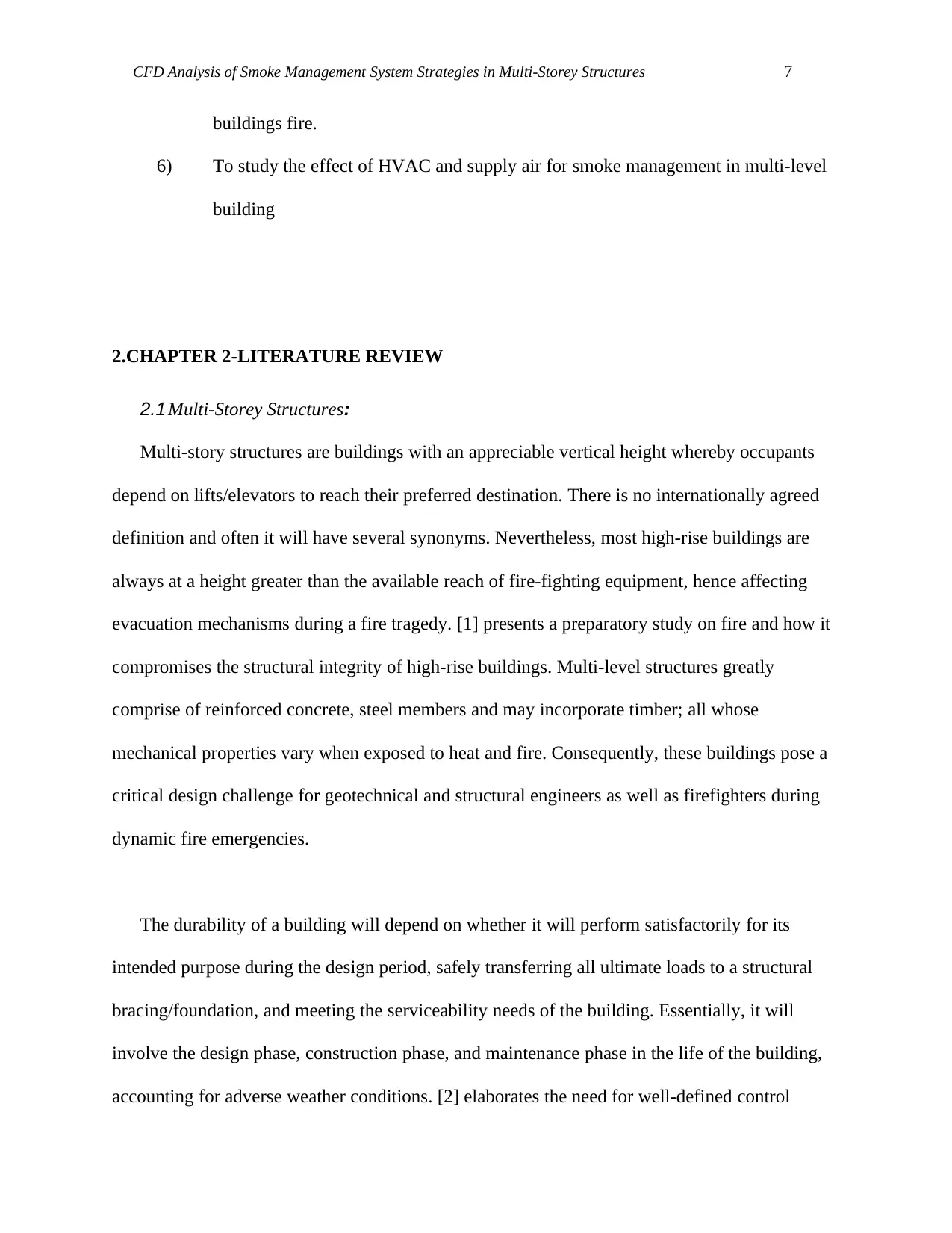
CFD Analysis of Smoke Management System Strategies in Multi-Storey Structures 7
buildings fire.
6) To study the effect of HVAC and supply air for smoke management in multi-level
building
2.CHAPTER 2-LITERATURE REVIEW
2.1 Multi-Storey Structures:
Multi-story structures are buildings with an appreciable vertical height whereby occupants
depend on lifts/elevators to reach their preferred destination. There is no internationally agreed
definition and often it will have several synonyms. Nevertheless, most high-rise buildings are
always at a height greater than the available reach of fire-fighting equipment, hence affecting
evacuation mechanisms during a fire tragedy. [1] presents a preparatory study on fire and how it
compromises the structural integrity of high-rise buildings. Multi-level structures greatly
comprise of reinforced concrete, steel members and may incorporate timber; all whose
mechanical properties vary when exposed to heat and fire. Consequently, these buildings pose a
critical design challenge for geotechnical and structural engineers as well as firefighters during
dynamic fire emergencies.
The durability of a building will depend on whether it will perform satisfactorily for its
intended purpose during the design period, safely transferring all ultimate loads to a structural
bracing/foundation, and meeting the serviceability needs of the building. Essentially, it will
involve the design phase, construction phase, and maintenance phase in the life of the building,
accounting for adverse weather conditions. [2] elaborates the need for well-defined control
buildings fire.
6) To study the effect of HVAC and supply air for smoke management in multi-level
building
2.CHAPTER 2-LITERATURE REVIEW
2.1 Multi-Storey Structures:
Multi-story structures are buildings with an appreciable vertical height whereby occupants
depend on lifts/elevators to reach their preferred destination. There is no internationally agreed
definition and often it will have several synonyms. Nevertheless, most high-rise buildings are
always at a height greater than the available reach of fire-fighting equipment, hence affecting
evacuation mechanisms during a fire tragedy. [1] presents a preparatory study on fire and how it
compromises the structural integrity of high-rise buildings. Multi-level structures greatly
comprise of reinforced concrete, steel members and may incorporate timber; all whose
mechanical properties vary when exposed to heat and fire. Consequently, these buildings pose a
critical design challenge for geotechnical and structural engineers as well as firefighters during
dynamic fire emergencies.
The durability of a building will depend on whether it will perform satisfactorily for its
intended purpose during the design period, safely transferring all ultimate loads to a structural
bracing/foundation, and meeting the serviceability needs of the building. Essentially, it will
involve the design phase, construction phase, and maintenance phase in the life of the building,
accounting for adverse weather conditions. [2] elaborates the need for well-defined control
Paraphrase This Document
Need a fresh take? Get an instant paraphrase of this document with our AI Paraphraser
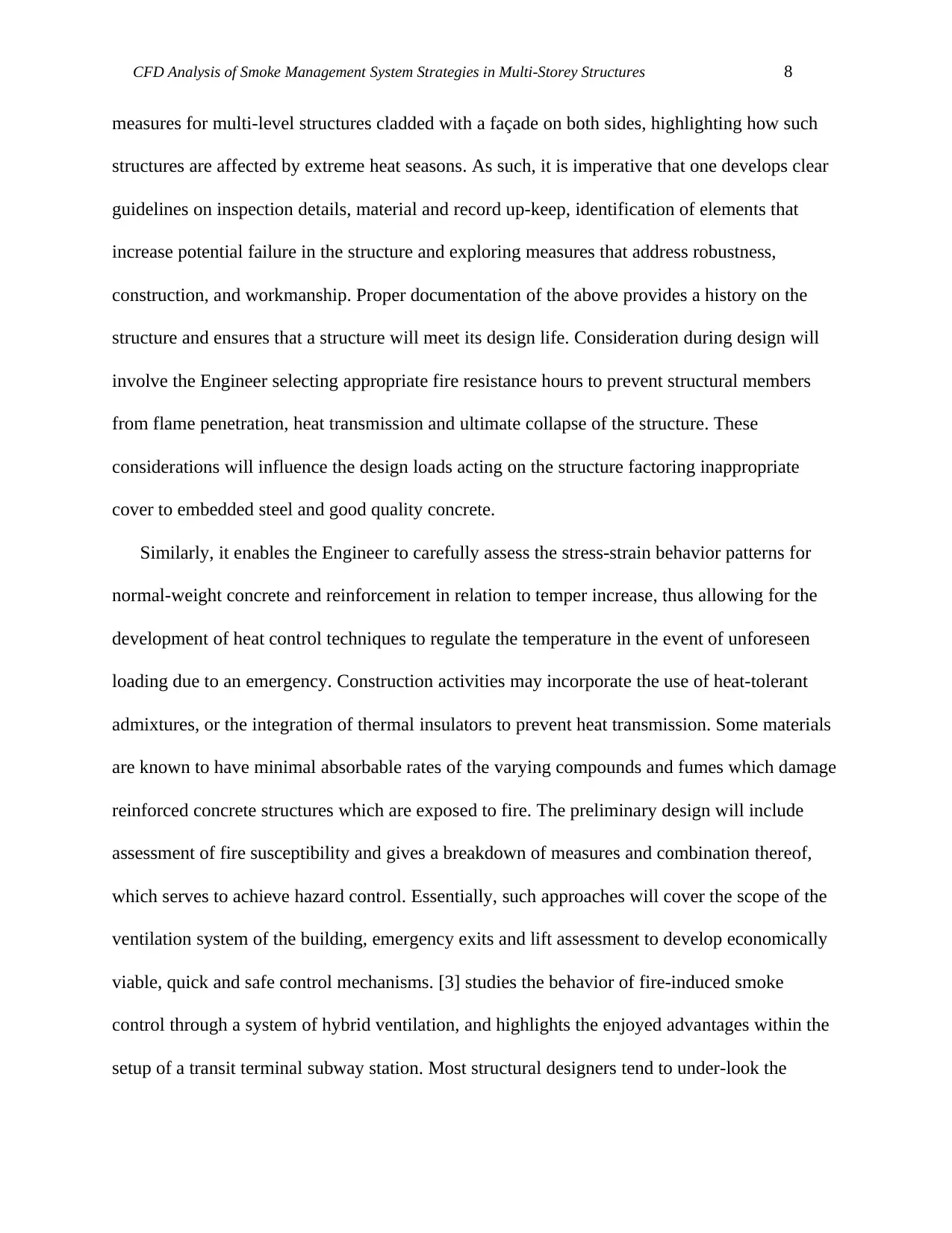
CFD Analysis of Smoke Management System Strategies in Multi-Storey Structures 8
measures for multi-level structures cladded with a façade on both sides, highlighting how such
structures are affected by extreme heat seasons. As such, it is imperative that one develops clear
guidelines on inspection details, material and record up-keep, identification of elements that
increase potential failure in the structure and exploring measures that address robustness,
construction, and workmanship. Proper documentation of the above provides a history on the
structure and ensures that a structure will meet its design life. Consideration during design will
involve the Engineer selecting appropriate fire resistance hours to prevent structural members
from flame penetration, heat transmission and ultimate collapse of the structure. These
considerations will influence the design loads acting on the structure factoring inappropriate
cover to embedded steel and good quality concrete.
Similarly, it enables the Engineer to carefully assess the stress-strain behavior patterns for
normal-weight concrete and reinforcement in relation to temper increase, thus allowing for the
development of heat control techniques to regulate the temperature in the event of unforeseen
loading due to an emergency. Construction activities may incorporate the use of heat-tolerant
admixtures, or the integration of thermal insulators to prevent heat transmission. Some materials
are known to have minimal absorbable rates of the varying compounds and fumes which damage
reinforced concrete structures which are exposed to fire. The preliminary design will include
assessment of fire susceptibility and gives a breakdown of measures and combination thereof,
which serves to achieve hazard control. Essentially, such approaches will cover the scope of the
ventilation system of the building, emergency exits and lift assessment to develop economically
viable, quick and safe control mechanisms. [3] studies the behavior of fire-induced smoke
control through a system of hybrid ventilation, and highlights the enjoyed advantages within the
setup of a transit terminal subway station. Most structural designers tend to under-look the
measures for multi-level structures cladded with a façade on both sides, highlighting how such
structures are affected by extreme heat seasons. As such, it is imperative that one develops clear
guidelines on inspection details, material and record up-keep, identification of elements that
increase potential failure in the structure and exploring measures that address robustness,
construction, and workmanship. Proper documentation of the above provides a history on the
structure and ensures that a structure will meet its design life. Consideration during design will
involve the Engineer selecting appropriate fire resistance hours to prevent structural members
from flame penetration, heat transmission and ultimate collapse of the structure. These
considerations will influence the design loads acting on the structure factoring inappropriate
cover to embedded steel and good quality concrete.
Similarly, it enables the Engineer to carefully assess the stress-strain behavior patterns for
normal-weight concrete and reinforcement in relation to temper increase, thus allowing for the
development of heat control techniques to regulate the temperature in the event of unforeseen
loading due to an emergency. Construction activities may incorporate the use of heat-tolerant
admixtures, or the integration of thermal insulators to prevent heat transmission. Some materials
are known to have minimal absorbable rates of the varying compounds and fumes which damage
reinforced concrete structures which are exposed to fire. The preliminary design will include
assessment of fire susceptibility and gives a breakdown of measures and combination thereof,
which serves to achieve hazard control. Essentially, such approaches will cover the scope of the
ventilation system of the building, emergency exits and lift assessment to develop economically
viable, quick and safe control mechanisms. [3] studies the behavior of fire-induced smoke
control through a system of hybrid ventilation, and highlights the enjoyed advantages within the
setup of a transit terminal subway station. Most structural designers tend to under-look the
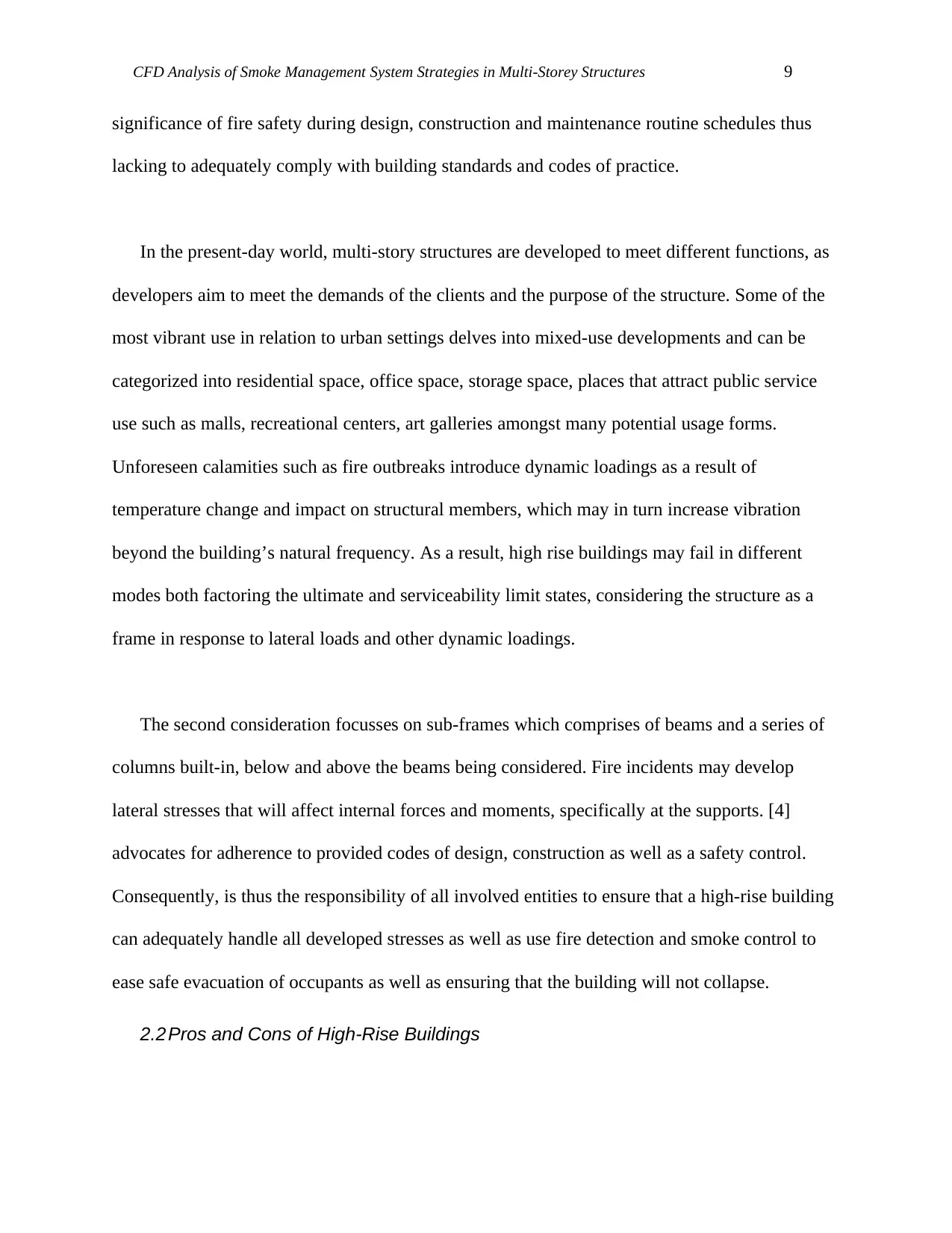
CFD Analysis of Smoke Management System Strategies in Multi-Storey Structures 9
significance of fire safety during design, construction and maintenance routine schedules thus
lacking to adequately comply with building standards and codes of practice.
In the present-day world, multi-story structures are developed to meet different functions, as
developers aim to meet the demands of the clients and the purpose of the structure. Some of the
most vibrant use in relation to urban settings delves into mixed-use developments and can be
categorized into residential space, office space, storage space, places that attract public service
use such as malls, recreational centers, art galleries amongst many potential usage forms.
Unforeseen calamities such as fire outbreaks introduce dynamic loadings as a result of
temperature change and impact on structural members, which may in turn increase vibration
beyond the building’s natural frequency. As a result, high rise buildings may fail in different
modes both factoring the ultimate and serviceability limit states, considering the structure as a
frame in response to lateral loads and other dynamic loadings.
The second consideration focusses on sub-frames which comprises of beams and a series of
columns built-in, below and above the beams being considered. Fire incidents may develop
lateral stresses that will affect internal forces and moments, specifically at the supports. [4]
advocates for adherence to provided codes of design, construction as well as a safety control.
Consequently, is thus the responsibility of all involved entities to ensure that a high-rise building
can adequately handle all developed stresses as well as use fire detection and smoke control to
ease safe evacuation of occupants as well as ensuring that the building will not collapse.
2.2 Pros and Cons of High-Rise Buildings
significance of fire safety during design, construction and maintenance routine schedules thus
lacking to adequately comply with building standards and codes of practice.
In the present-day world, multi-story structures are developed to meet different functions, as
developers aim to meet the demands of the clients and the purpose of the structure. Some of the
most vibrant use in relation to urban settings delves into mixed-use developments and can be
categorized into residential space, office space, storage space, places that attract public service
use such as malls, recreational centers, art galleries amongst many potential usage forms.
Unforeseen calamities such as fire outbreaks introduce dynamic loadings as a result of
temperature change and impact on structural members, which may in turn increase vibration
beyond the building’s natural frequency. As a result, high rise buildings may fail in different
modes both factoring the ultimate and serviceability limit states, considering the structure as a
frame in response to lateral loads and other dynamic loadings.
The second consideration focusses on sub-frames which comprises of beams and a series of
columns built-in, below and above the beams being considered. Fire incidents may develop
lateral stresses that will affect internal forces and moments, specifically at the supports. [4]
advocates for adherence to provided codes of design, construction as well as a safety control.
Consequently, is thus the responsibility of all involved entities to ensure that a high-rise building
can adequately handle all developed stresses as well as use fire detection and smoke control to
ease safe evacuation of occupants as well as ensuring that the building will not collapse.
2.2 Pros and Cons of High-Rise Buildings
⊘ This is a preview!⊘
Do you want full access?
Subscribe today to unlock all pages.

Trusted by 1+ million students worldwide
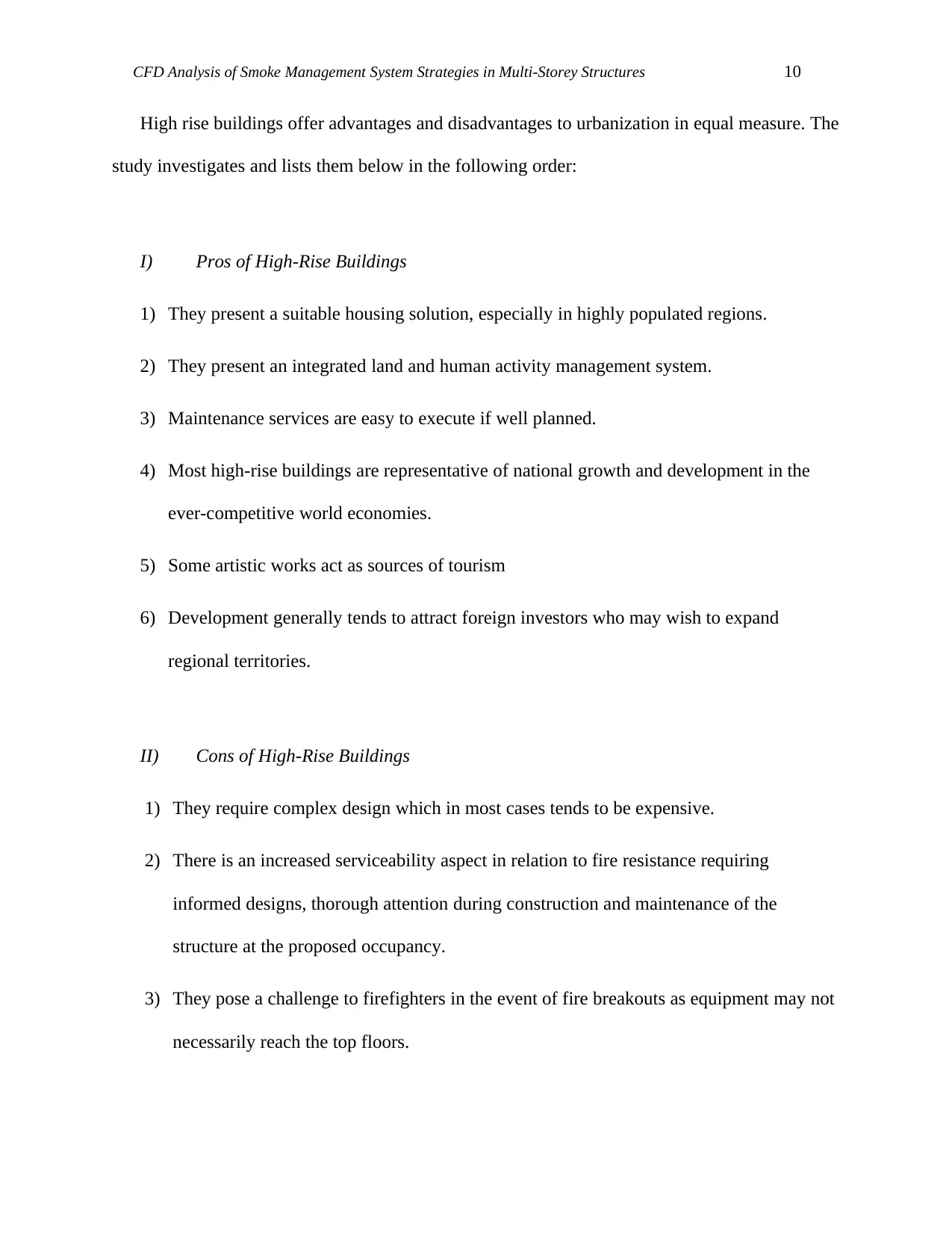
CFD Analysis of Smoke Management System Strategies in Multi-Storey Structures 10
High rise buildings offer advantages and disadvantages to urbanization in equal measure. The
study investigates and lists them below in the following order:
I) Pros of High-Rise Buildings
1) They present a suitable housing solution, especially in highly populated regions.
2) They present an integrated land and human activity management system.
3) Maintenance services are easy to execute if well planned.
4) Most high-rise buildings are representative of national growth and development in the
ever-competitive world economies.
5) Some artistic works act as sources of tourism
6) Development generally tends to attract foreign investors who may wish to expand
regional territories.
II) Cons of High-Rise Buildings
1) They require complex design which in most cases tends to be expensive.
2) There is an increased serviceability aspect in relation to fire resistance requiring
informed designs, thorough attention during construction and maintenance of the
structure at the proposed occupancy.
3) They pose a challenge to firefighters in the event of fire breakouts as equipment may not
necessarily reach the top floors.
High rise buildings offer advantages and disadvantages to urbanization in equal measure. The
study investigates and lists them below in the following order:
I) Pros of High-Rise Buildings
1) They present a suitable housing solution, especially in highly populated regions.
2) They present an integrated land and human activity management system.
3) Maintenance services are easy to execute if well planned.
4) Most high-rise buildings are representative of national growth and development in the
ever-competitive world economies.
5) Some artistic works act as sources of tourism
6) Development generally tends to attract foreign investors who may wish to expand
regional territories.
II) Cons of High-Rise Buildings
1) They require complex design which in most cases tends to be expensive.
2) There is an increased serviceability aspect in relation to fire resistance requiring
informed designs, thorough attention during construction and maintenance of the
structure at the proposed occupancy.
3) They pose a challenge to firefighters in the event of fire breakouts as equipment may not
necessarily reach the top floors.
Paraphrase This Document
Need a fresh take? Get an instant paraphrase of this document with our AI Paraphraser
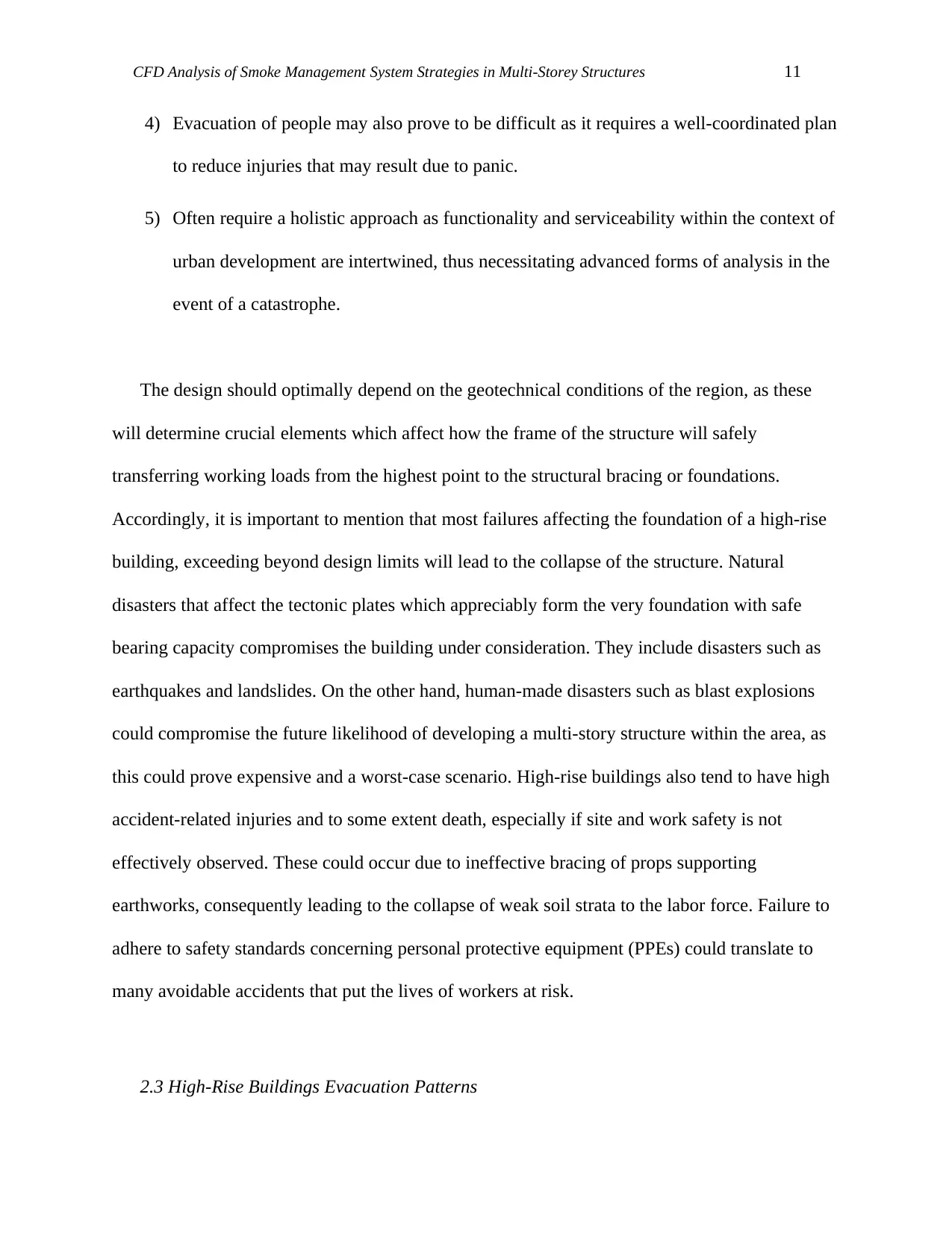
CFD Analysis of Smoke Management System Strategies in Multi-Storey Structures 11
4) Evacuation of people may also prove to be difficult as it requires a well-coordinated plan
to reduce injuries that may result due to panic.
5) Often require a holistic approach as functionality and serviceability within the context of
urban development are intertwined, thus necessitating advanced forms of analysis in the
event of a catastrophe.
The design should optimally depend on the geotechnical conditions of the region, as these
will determine crucial elements which affect how the frame of the structure will safely
transferring working loads from the highest point to the structural bracing or foundations.
Accordingly, it is important to mention that most failures affecting the foundation of a high-rise
building, exceeding beyond design limits will lead to the collapse of the structure. Natural
disasters that affect the tectonic plates which appreciably form the very foundation with safe
bearing capacity compromises the building under consideration. They include disasters such as
earthquakes and landslides. On the other hand, human-made disasters such as blast explosions
could compromise the future likelihood of developing a multi-story structure within the area, as
this could prove expensive and a worst-case scenario. High-rise buildings also tend to have high
accident-related injuries and to some extent death, especially if site and work safety is not
effectively observed. These could occur due to ineffective bracing of props supporting
earthworks, consequently leading to the collapse of weak soil strata to the labor force. Failure to
adhere to safety standards concerning personal protective equipment (PPEs) could translate to
many avoidable accidents that put the lives of workers at risk.
2.3 High-Rise Buildings Evacuation Patterns
4) Evacuation of people may also prove to be difficult as it requires a well-coordinated plan
to reduce injuries that may result due to panic.
5) Often require a holistic approach as functionality and serviceability within the context of
urban development are intertwined, thus necessitating advanced forms of analysis in the
event of a catastrophe.
The design should optimally depend on the geotechnical conditions of the region, as these
will determine crucial elements which affect how the frame of the structure will safely
transferring working loads from the highest point to the structural bracing or foundations.
Accordingly, it is important to mention that most failures affecting the foundation of a high-rise
building, exceeding beyond design limits will lead to the collapse of the structure. Natural
disasters that affect the tectonic plates which appreciably form the very foundation with safe
bearing capacity compromises the building under consideration. They include disasters such as
earthquakes and landslides. On the other hand, human-made disasters such as blast explosions
could compromise the future likelihood of developing a multi-story structure within the area, as
this could prove expensive and a worst-case scenario. High-rise buildings also tend to have high
accident-related injuries and to some extent death, especially if site and work safety is not
effectively observed. These could occur due to ineffective bracing of props supporting
earthworks, consequently leading to the collapse of weak soil strata to the labor force. Failure to
adhere to safety standards concerning personal protective equipment (PPEs) could translate to
many avoidable accidents that put the lives of workers at risk.
2.3 High-Rise Buildings Evacuation Patterns
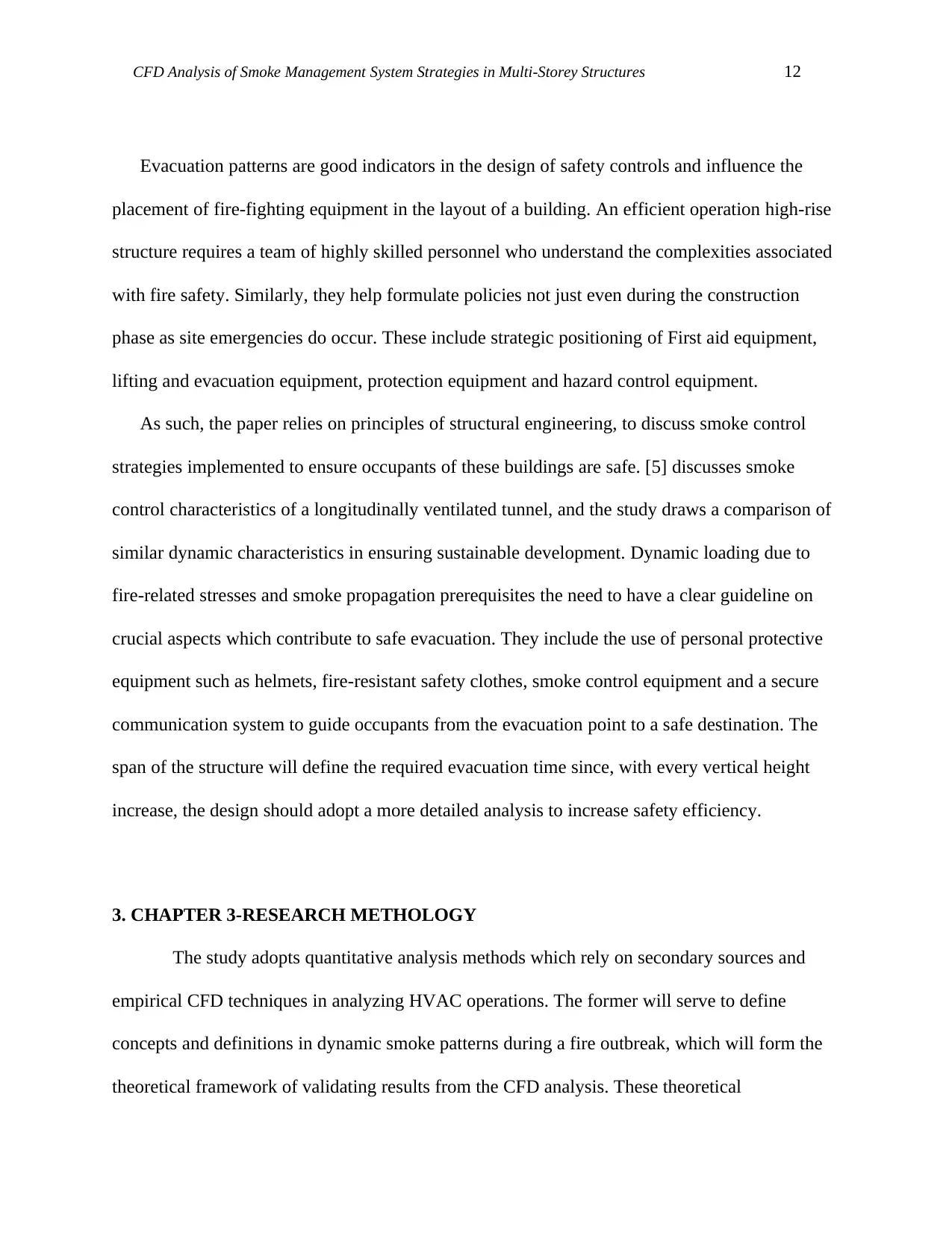
CFD Analysis of Smoke Management System Strategies in Multi-Storey Structures 12
Evacuation patterns are good indicators in the design of safety controls and influence the
placement of fire-fighting equipment in the layout of a building. An efficient operation high-rise
structure requires a team of highly skilled personnel who understand the complexities associated
with fire safety. Similarly, they help formulate policies not just even during the construction
phase as site emergencies do occur. These include strategic positioning of First aid equipment,
lifting and evacuation equipment, protection equipment and hazard control equipment.
As such, the paper relies on principles of structural engineering, to discuss smoke control
strategies implemented to ensure occupants of these buildings are safe. [5] discusses smoke
control characteristics of a longitudinally ventilated tunnel, and the study draws a comparison of
similar dynamic characteristics in ensuring sustainable development. Dynamic loading due to
fire-related stresses and smoke propagation prerequisites the need to have a clear guideline on
crucial aspects which contribute to safe evacuation. They include the use of personal protective
equipment such as helmets, fire-resistant safety clothes, smoke control equipment and a secure
communication system to guide occupants from the evacuation point to a safe destination. The
span of the structure will define the required evacuation time since, with every vertical height
increase, the design should adopt a more detailed analysis to increase safety efficiency.
3. CHAPTER 3-RESEARCH METHOLOGY
The study adopts quantitative analysis methods which rely on secondary sources and
empirical CFD techniques in analyzing HVAC operations. The former will serve to define
concepts and definitions in dynamic smoke patterns during a fire outbreak, which will form the
theoretical framework of validating results from the CFD analysis. These theoretical
Evacuation patterns are good indicators in the design of safety controls and influence the
placement of fire-fighting equipment in the layout of a building. An efficient operation high-rise
structure requires a team of highly skilled personnel who understand the complexities associated
with fire safety. Similarly, they help formulate policies not just even during the construction
phase as site emergencies do occur. These include strategic positioning of First aid equipment,
lifting and evacuation equipment, protection equipment and hazard control equipment.
As such, the paper relies on principles of structural engineering, to discuss smoke control
strategies implemented to ensure occupants of these buildings are safe. [5] discusses smoke
control characteristics of a longitudinally ventilated tunnel, and the study draws a comparison of
similar dynamic characteristics in ensuring sustainable development. Dynamic loading due to
fire-related stresses and smoke propagation prerequisites the need to have a clear guideline on
crucial aspects which contribute to safe evacuation. They include the use of personal protective
equipment such as helmets, fire-resistant safety clothes, smoke control equipment and a secure
communication system to guide occupants from the evacuation point to a safe destination. The
span of the structure will define the required evacuation time since, with every vertical height
increase, the design should adopt a more detailed analysis to increase safety efficiency.
3. CHAPTER 3-RESEARCH METHOLOGY
The study adopts quantitative analysis methods which rely on secondary sources and
empirical CFD techniques in analyzing HVAC operations. The former will serve to define
concepts and definitions in dynamic smoke patterns during a fire outbreak, which will form the
theoretical framework of validating results from the CFD analysis. These theoretical
⊘ This is a preview!⊘
Do you want full access?
Subscribe today to unlock all pages.

Trusted by 1+ million students worldwide
1 out of 60
Your All-in-One AI-Powered Toolkit for Academic Success.
+13062052269
info@desklib.com
Available 24*7 on WhatsApp / Email
![[object Object]](/_next/static/media/star-bottom.7253800d.svg)
Unlock your academic potential
Copyright © 2020–2025 A2Z Services. All Rights Reserved. Developed and managed by ZUCOL.